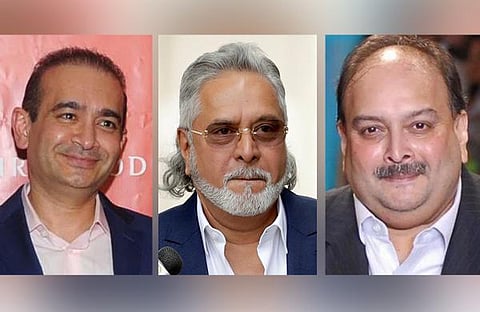

The RBI throwing open a debt recovery opportunity for lenders was indeed a Rs 3.4 lakh crore surprise.
Issuing a circular last week, the banking regulator allowed banks and financial institutions to enter into compromise settlements with wilful defaulters, who until now were kept out of it.
It means all wilful defaulters including Vijay Mallya, Nirav Modi and Mehul Choksi, who collectively owe more than Rs 3.4 lakh crore can pay up, get off the defaulters list and, as a bonus, avail fresh loans, provided bank boards agree.
Now is the time for banks to prove that if they can be compassionate lenders, they can become compassionate collectors of debt too. After all, as they say, the only man closer to you during adversity than a friend is a creditor. Moreover, settlement is a quicker way to recover dues, which perhaps the RBI too agrees with, and hence this move allowing lenders to talk it out and settle.
Wilful defaulters are those who have the genuine capability to pay, but instead exercise ingenuity to avoid dues. In some cases, evidence of misuse of funds or diversion of funds is even established, confirming intentional wrongdoing. A compromise settlement offers an incentive for banks to maximize recoveries at minimum expense, while defaulters get access to bank credit after a cooling-off period.
ALSO READ | Remembering Ambedkar, the accomplished economist
What could this lead to? For one, Mallya's Rs 14,000-crore settlement offer that banks rejected in the past could make a grand comeback with due revisions. Or could it? Remember such settlements won't absolve Mallya or for that matter any wilful defaulter from ongoing criminal or legal litigations. So, it'll be interesting to see how many defaulters, who were thrown out of business, with some even absconding, prove willing to clear their dues without getting any legal respite.
The central bank is facing flak from various quarters on the grounds that permitting compromise settlements for wilful defaulters rewards dishonest borrowers and hurts credit discipline. But the genesis for opening up the option for wilful defaulters out of the blue could be for two reasons.
One, could be the steady rise in wilful defaults. In the past two years, they jumped by 38% from Rs 2.4 lakh crore as on December 2020 to Rs 3.4 lakh crore as on December 2022. Two, could be due to a potential disparity in classifying wilful defaults.
As Anil Gupta, Co-Group Head - Financial Sector Ratings, ICRA Ratings observed, one bank may classify a borrower as a wilful defaulter but another may treat the same borrower as a business failure case in the future and give credit.
"In any case, banks are already extending loans to companies that have defaulted in the past or settled loans after high haircuts... Essentially, this is more of a principle-based regulation, where the onus lies with banks' boards rather than a prescription-based regulation where RBI specifies what needs to be done," Gupta noted.
FROM OUR ARCHIVES | Global debt rising at alarming rate
RBI's Compromise Settlement framework dates back to July 1995, when it allowed lenders to frame their own board-approved policies for One Time Settlements(OTS)/Compromise settlements. It has been revising instructions since then for loans up to Rs 5 crore, and for up to Rs 10 crore and above separately. OTS and compromise settlements are totally different schemes with different terms and conditions.
According to data tabled in the Parliament, 11 banks managed to recover just about Rs 61,000 crore by way of OTS between FY19 and FY22 (data furnished only up to December 2021 for FY22 fiscal).
It's unclear how much banks recovered via compromise settlements alone, but there have been reports of its misuse. In the past, RBI had warned banks of misusing the settlement scheme following complaints from Debt Recovery Tribunals (DRTs) that banks were entering compromise settlements without them. So, if banks initiate recovery proceedings through a judicial forum and the case is still pending, any settlement reached with the borrower should be subject to obtaining a consent decree from the relevant judicial authorities.
But exactly how much can be recovered? There are no easy answers. "For lenders, it's a dilemma, whether to settle and move on or remain involved in litigation. The policy has to be one that prevents misuse, but at the same time maximize recovery of dues. It's expected that lenders will thoroughly weigh the costs vs benefits of such reaching such a compromise settlement on a case-to-case basis," Gupta said.
Of the Rs 3.4 lakh crore worth of wilful defaults, the top 50 borrowers alone account for about Rs 1 lakh crore in unpaid dues. Even if lenders manage to settle with large borrowers, debt recovery collection rates will jump significantly.
According to data tabled in Parliament last December, of the Rs 11.17 lakh crore bad loans that were written off in the past six years, a mere Rs 1.3 lakh crore was recovered.